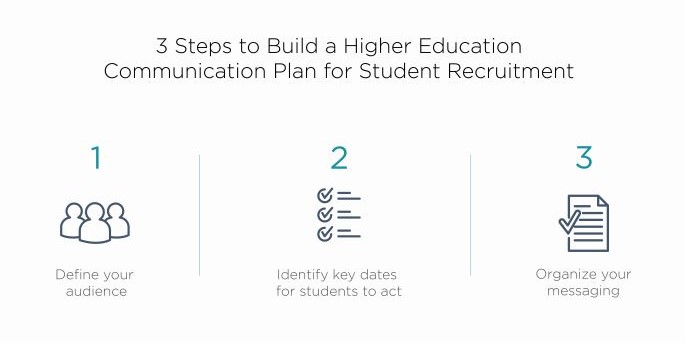
Stamats Insights
October 31, 2022
Colleges and universities often grapple with planning and executing dynamic recruitment communication plans. The reasons for this may center around the lack of staff and technology resources to launch and maintain the plan. Sometimes it’s due to underestimating the importance of strategically communicating with potential students—or not knowing how or where to start.
When I started working with communication plans over 10 years ago, there were little to no resources available to extract from and synthesize into something to use. Over time, I learned (sometimes the hard way!) a series of key steps to consider when building a communication plan to reach engaged prospective students, families, and influencers—and ultimately increase matriculation.
If you run into a snag, please feel free to reach out to me—I am happy to clear up areas that may be particularly tough to navigate.
Each audience naturally needs a different message and call-to-action (CTA). Creating a one-size fits all message is disastrous—this method will result in extra phone calls, chats from confused students, and family members trying to navigate through the message of steps one must take.
For instance, a message sent to high school seniors that FAFSA is open on October 1 is a fantastic touch point to help students find their path toward attending your college. Supplying helpful information for that step only in the message, such as your school code to input on the application, can engage students in your school. This also sets you up to be the expert in your field and builds trust with potential students and their family members.
But if you include a bunch of other steps, your timely note will get lost in the clutter, leaving prospective students disengaged and confused.
Define your channel of who to talk to and keep to it. Examples of audiences for recruitment may include:
Messages may overlap later in the recruitment cycle, but early contact should ALWAYS stick with one message and CTA and include only information that is timely and relevant for that audience.
In the beginning, it may be difficult to come up with dates. Most key dates are part of the lexicon of higher ed and are second nature to internal business processes. Because of the second nature of a regular cycle of dates, it is difficult to slow processes and identify key items that are highlighted in a communication. Examples of events that you could message may include:
And remember to include dates that matter to the applicant pool. Students who have entered the application process are still at a recruitment stage and could benefit from strategic messaging about key application dates. Generally, applicants are found in three phases:
It is not unusual for applicants to apply to multiple schools when choosing a path. Make sure you continue to communicate with and recruit this audience, so you continue to shine and help them find their way to your college.
Once dates for deadlines and events are cataloged, the next step is to organize messaging to the appropriate audiences with dates to send, including reminder messages that may follow these key dates’ announcements.

As part of this step, you’ll need to decide how many messages and when to start the campaign leading up to the event. Different kinds of events warrant differing lead times. For example, the average Preview Day is usually promoted 60 days prior because of the lead time families need to plan the trip, budget, and take time off work.
If your school is offering a recruitment event that is longer than a day or half a day, provide a bit of a longer lead time for travel planning. Also, consider the size of the event to host. If the event is sized for 30 students, the lead time can be closer to 60 days.
Another tip is to pull demographics of the past three years’ worth of events (acknowledging COVID-19 outliers) for distance and learn the average radius from which your school pulls. If driving time averages less than a day, this helps provide insights into the audience’s potential travel plans to attend. If the radius is less than 200 miles, this is considered “in proximity.” And if the draw is more than 250 miles, give extra marketing time to help accommodate travel arrangements.
In contrast, events needing a longer lead time—such as homecoming, commencement, or multi-day recruitment events—may tax the city or town’s lodging capabilities. So, it is best to give ample time for families to book accommodations. The audience your school is communicating with expands for larger events, too. This means longer lead times for promotion to reach audiences that are farther away.
I usually use a spreadsheet format to organize my messaging—that way, it’s easy to move from data-segmented campaign contact lists to crafting messages, without having to switch between programs. Each column supplies the header of pertinent information such as the title of the message and important notes to keep in mind when building the communication.
Examples of headers can include:
Messages to consider are all about the students and families:
Carefully consider the audience when crafting messages. Any emails that have a link to apply should never land in the inboxes of juniors in high school. Generally, juniors in high school cannot legally apply to attend college. There are exceptions, but these are rare. If you have a message for all audiences and there is information about applying, clone the email. Then send two emails: one for those who can apply and one that has no reference to applying for younger audiences.
Once send dates are established, layer in the additional supporting materials to use for communications, such as postcards, texting, and social media.
These three steps will start you on your way toward a planned and strategic communication plan that will support recruitment and retention efforts. If you have these established and are looking to grow, we’re happy to meet and discuss what your institution wants to achieve. Stamats provide services that are scalable to extend areas where your institution is functioning and supplement where there are opportunities to grow.
These steps will help with the framework of how to take your recruitment outreach from good to great. A strategic communication plan can increase matriculation and help new students start class with less frustration, thanks to your proverbial trail of key dates in obtaining an education.
We’d love to help you develop your strategy, build a communication plan, or optimize your enrollment campaign. Connect with Marianne Sipe to learn more about accelerating your enrollment growth.
Ready to Get Started?
Reach out to us to talk about your strategy and goals.